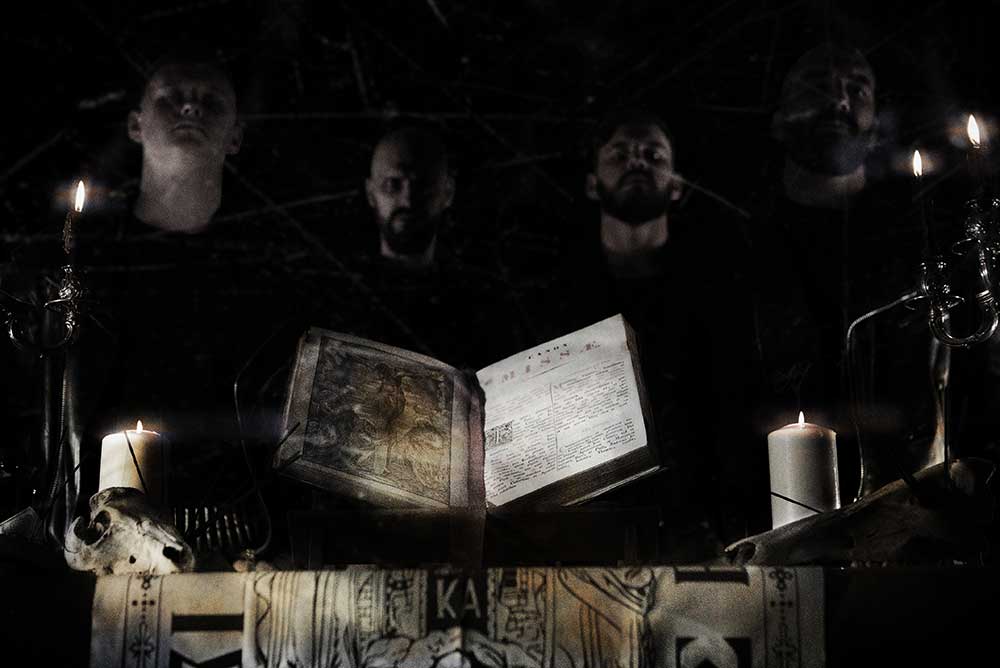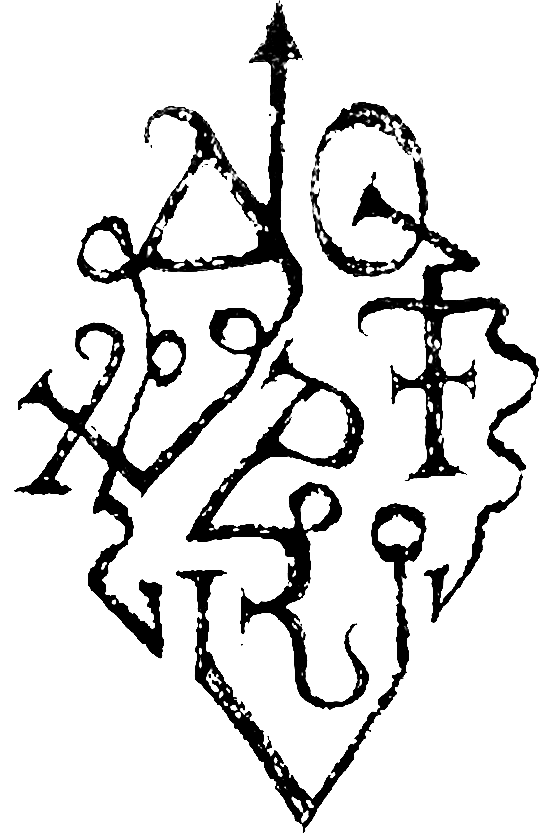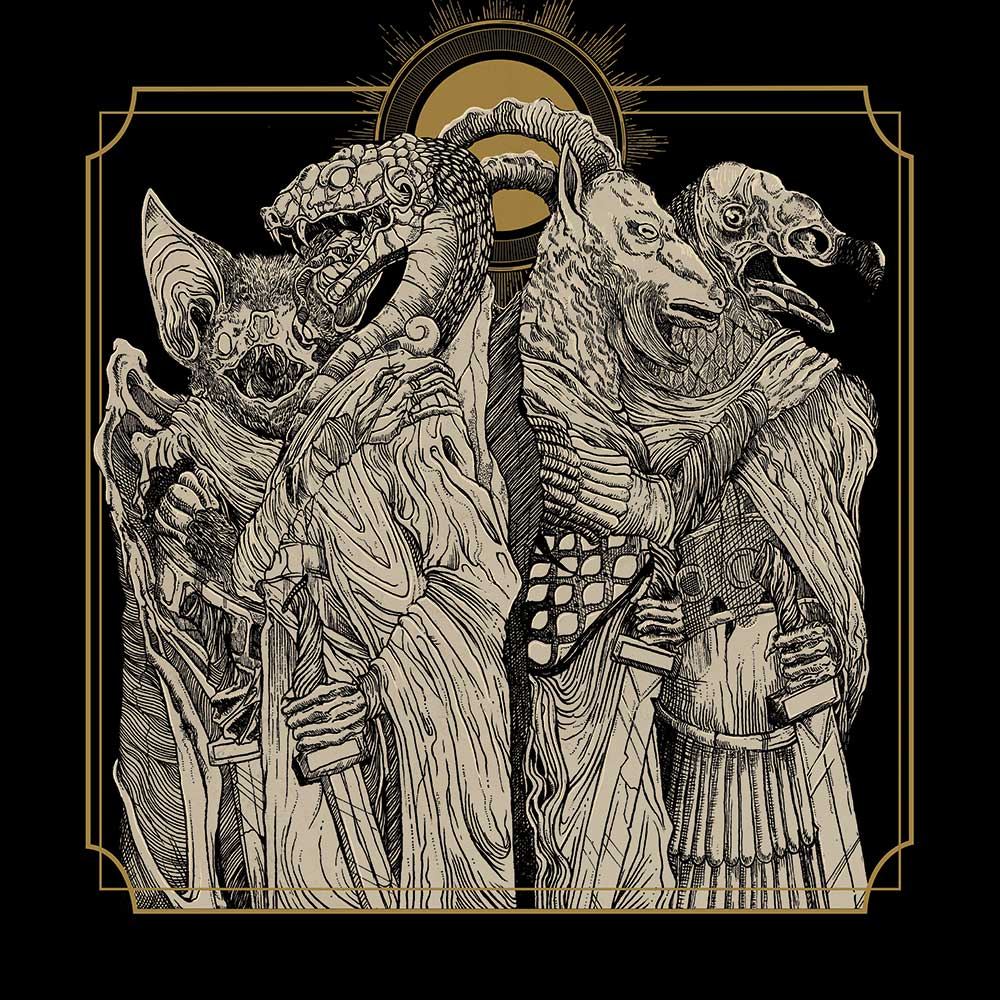Idolatria
2020-09-09
by Niklas Göransson
Italian black metal band Idolatria explore the links between myth and history by fusing beast with man – B. S. Hircus and M. T. Iracundus discuss the craft and concept behind their new album, Tetrabestiarchy.
– “Tetrabestiarchy” is certainly not easy listening, says drummer B. S. Hircus, it contains many different influences and touches. Perhaps it would’ve been more accessible with a clearer production, but that just wouldn’t have been an IDOLATRIA record. We believe black metal should always bring some kind of filth to your ears.
“Tetrabestiarchy”, the second album of Italian black metal quartet IDOLATRIA, was released on September 4 by Portuguese label Signal Rex.
– Musically speaking, says guitarist M. T. Iracundus, it’s very diverse. There are some obvious lodestars, mainly from the Icelandic scene, but I’ve always listened to every kind of black and death metal – from ANOREXIA NERVOSA to MAYHEM, from DEATHSPELL OMEGA to BÖLZER, and from PORTAL to DARK TRANQUILLITY. Not having a readily defined framework to adhere to helps me include as many elements as possible, all the while promoting effective transitions between parts. Or, fuck the slow transition and get your face smashed in by a hammer – that can be interesting too, haha! The beauty of composing lies in first creating rules and then destroying them.
IDOLATRIA’s 2015 debut album, “Breviarium Daemonicus Idolatrorum”, was firmly entrenched in the bestial black/death sound. “Tetrabestiarchy” retains many such qualities, but also introduces atmospheric elements by way of samples and keyboards.
– Guitar, bass, drums and vocals are the foundations of our music, says Iracundus. In order for a song to be considered valid, we believe it must sound good even when stripped down to the core. These days, samples, overdubs, and so on are overused in order to fill serious compositional gaps. This pop music mentality has definitely begun seeping into extreme metal over the years. I add extra elements – synths, simulated classical instruments, layers of effected guitars, sound manipulations, and so forth – whenever I deem them necessary. I’ve studied contemporary and experimental music, so expressing myself through sounds of this kind is a natural part of my musical heritage. In fact, both the opening and closing tracks are my compositions. Nevertheless, a good riff, pounding drums, and an impactful voice are the main components of black metal, and they should never be overshadowed; therefore, we always make sure that our songs sound good in the rehearsal room, without the aid of backing tracks.

The drums were tracked in a huge 18th-century villa in their hometown of Pordenone. The building is owned by the town administration and was, at the time, leased to a few different companies. One of them was Artesonika Recording Studio, where Iracundus was employed as a sound engineer.
– We had a bunch of nice rooms, both for rehearsals and tracking. The central common hall – which is a hundred square metres and almost two floors high – was used for concerts, conferences and other events. Whenever necessary, I used it for recordings: a few jazz ensembles, some pianists, classical guitarists, and such. When it was time to hit the studio, we already knew which sound to aim for. The drums had to be huge, natural, and infused with a chaotic substrate, so that hall was the perfect choice. Although acoustically treated, it was designed for a much softer kind of music; certainly not for violent blast beats, haha!
– I must confess, says Hircus, I was a bit puzzled when Iracundus suggested this hall. I’ve always recorded my drums in small rooms, so I couldn’t foresee the result. But after my first listen, I knew it was the right choice. The ambient microphones gave the drumming a different kind of atmosphere that works well with the black metal genre. It was an amazing experience! It’s definitely something I’d recommend to those who want to experiment.
– I don’t like overproduced metal, continues Iracundus, nor do I care for stuff that’s so lo-fi you can’t hear shit. On the one hand, “Tetrabestiarchy” sounds modern because all elements are defined. On the other, it sounds old-school because there’s this unclear layer lingering every second. Unfortunately, the town administration has since terminated the rental contract and given sole management of the villa to a multinational corporation. If you think that Italy is the cradle of art and a country where such pursuits are valued, you are wrong! Years ago, I had the studio in a nice venue with a capacity of one thousand people; it was the biggest in our area, where GHOST, SATYRICON, DEATH TO ALL and many others played. They forced us to close! Honestly, I’m not surprised that Italy is less and less included in the various tours.
Leading up to the interview, you mentioned that there wasn’t much going on in the Italian scene even before COVID?
– Many years ago, we played in decadent bars and pubs – we were eager to destroy those places and often found ourselves completely drunk in some neighbour’s backyard. It was madness! We had small festivals in the woods and the police would come to drive us out. We were kids and had all the energy to do this kind of shit. Nowadays, there are only DJs and tribute bands. It’s a hassle to get big bands to play, let alone smaller ones. Young people have no proper space to rehearse and perform. FIDES INVERSA is one of the few Italian black metal bands that have stood out in recent years. OPERA IX and MORTUARY DRAPE definitely have an important history and a solid fan base. But I must say, the underground black metal scene has remained the most genuine during these years; there’s far less contamination by popular culture. Maybe because it’s not just about music, but real-life philosophy.

You also said that IDOLATRIA has ambitious plans to grow beyond a mere hobby – can you elaborate?
– In the past, we all had different projects… some of which turned out to be complete failures, haha! But, in the end, you don’t get any satisfaction from handling things casually. We’re tired of playing in front of the usual four assholes, exchanging CDs between other supporting acts, and getting paid with beers. We’ve already done that. We’re not kids anymore; we now aspire to something more, all the while keeping our feet planted on the ground. In essence, IDOLATRIA has become a small enterprise and, as such, there are some investments to be made. If you need something like artwork or mastering done properly, then you call a professional – not your girlfriend or a cousin – which is why we worked with Cold Poison and Stephen Lockhart. Nor did we accept the first record deal we stumbled upon: the search for a proper label was long. We want to work with capable people who believe in us, Signal Rex showed real interest in our work and has been doing everything to support it. Honestly, running the band is not too complex either. Everyone has their own task and we confront each other daily, but we’re definitely not selling any vital organs for promotion.
These days, it seems to be far harder to make a lasting name for oneself. New bands can still attain significant popularity but, in most cases, people seem to quickly move on and the groundswell dissipates as rapidly as it appeared. Veteran acts have longevity and history to bolster them and their fans are loyal, but a lot of younger bands don’t seem to acquire that kind of following.
– You are perfectly right, and it’s not as if we’re expecting to make a living out of this – but one must aim high in order to have any chance of gaining a result. The metal scene these days is as saturated as it is complicated. Most of the time, even if you have a nice product, it doesn’t necessarily mean you’ll be taking that next step. Your image, connections, online presence, etcetera are far more important. People no longer buy your music, they prefer t-shirts or a patch. I think this whole world, the music business, is quite illusory. From my work as a professional FOH engineer, this environment is not new to me. Bands with big productions and budgets headline every festival and tour, earning decent money, whilst all the others gasp for air. Considering this obvious limitation, our desire is to make interesting and meticulously crafted records released through a label with a nice following. Simply opening for or supporting bands we love is enough for us at the moment. We look to improve ourselves and give it our best efforts, but the important thing is to keep our feet on the ground. We go on with our lives, but our music must keep a serious approach: this is imperative for us!
– There’s always the desire to create something different and innovative in order to be remembered, says Hircus. In the last twenty years, we’ve followed the changes within the black metal scene; it seems face-painting has given way to robes and hoods, of which bands like MGŁA and SVARTIDAUÐI were pioneers. I was very impressed the first time I saw them live; it was a completely new way of expressing darkness. Suddenly, it had a huge impact on the scene, and we decided to use a similar approach for our first album. Finally, I think a good record remains so even without a big following. There are many lesser-known bands and labels with fucking good music, and I will always support them.

The cover artwork of “Tetrabestiarchy” – which, courtesy of Antithesis of Mexican art studio Cold Poison, shows four animal-human hybrids – is the visual representation of the album’s thematic content. The beasts on display are the serpent, noctule, goat, and vulture.
– The concept was created well before we’d even decided to make a record, says Hircus, I had various ideas in my head, many with historical connotations. Then, some time ago when I was researching stories and occult doctrines, I read about the Ophites – a Christian Gnostic sect that revered and celebrated the Serpent in the Garden of Eden, the corrupter of Adam and Eve – which gave me an idea. Here in Italy we live quite closely with out past and traditions, so I’d been looking for ways to link myth and history. On “Tetrabestiarchy”, myth is represented by these four animalistic figures, whereas history is told both by their collocation in different cultures and through association with the Portrait of the Four Tetrarchs.
Fixed on the corner façade of St Mark’s Basilica in Venice, Italy, stands a 4th century art installation known as the Portrait of the Four Tetrarchs – an arrangement of two separate sculptures, both showing two Roman emperors locked in an embrace. The sculpture is believed to represent the first Tetrarchy, a system of governance through which the Roman Empire – its reach spanning several continents at the time – was ruled by four patriarchs. When implemented by Emperor Diocletian in 293 AD, it marked the end of the Crisis of the Third Century: a long period of unrest and near-collapse ignited by the demise of Emperor Maximinus Thrax, as discussed in last year’s DAUTHA feature. With the Tetrarchy in place, Diocletian paved the way for the Byzantine Empire in the East whilst restoring some semblance of order in the West.
– The concept of adoring these figures is the proper link to our name, IDOLATRIA, which means idolatry. I’ve invested a lot of work into these lyrics; in one sense they’re quite direct but, at the same time, also able to create a wonderful suggestion. For instance, “Noctule – The Emperor of Scourge” narrates the tale of Brahmaparush, an Indian vampire who eats brains and then makes a ritual dance with the victim’s intestines. “Vulture – The God of Last Rites” describes a funeral rite known in Tibet as the sky burial. So, there is an actual historical basis… with some personal and artistic interpretations, of course. These animals transcend their form and become malignant god-like rulers, ready to subjugate this hollow world under one glorious anti-Christian kingdom.
Speaking of which, besides returning the Roman Empire to former glory, Emperor Diocletian, who was a faithful adherent to the old gods, is also known for his stark distaste for the emerging desert religion. He regarded Christianity as a foreign cult which caused division amongst the populace, creating a ‘state within the state’ with separate customs and values. After consulting with and getting the approval of the Pythia, the legendary oracle at the Delphic sanctuary – which was razed by the Christian emperor Theodosius ninety years later – he began what’s become known as the Diocletianic Persecution in February 303.
– Diocletian was often addressed as ‘Dukljan’: the adversary of God. That’s our link with the Tetrarchs and the Roman Empire. If some of your readers will visit Venice – or Piazza San Marco in particular – I hope they associate this amazing porphyry sculpture with our album! These concepts need to be carried forward, but, due to their inherent complexity, they’re definitely not for everyone. The whole “Hail Satan” motto is usually enough to satisfy most people… but, in 2020, there’s a need for something more; something deeper and darker.



